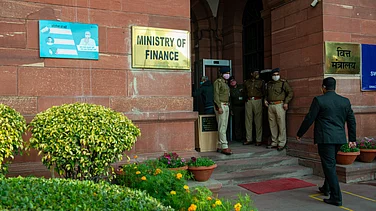The Reserve Bank of India announced the potential sale of government securities through open market operation (OMO), in its last monetary policy review announcement on October 6. The move in the words of RBI aims to manage liquidity conditions. However, the timing of this announcement suggests that the central bank is planning to hit three birds with one stone. By not disclosing the amount and timing of the sale, it somewhere hinted that the plan is to use the OMO tool at the most opportune time, where it can eventually prevent the Indian currency from falling further against the dollar.
OMO is primarily defined as a tool to manage liquidity by the RBI, who can either infuse liquidity into the system by purchasing bonds through this route, or drain it by selling. RBI through its purchases of these bonds gets to inject money into the banks, therefore, increasing the liquidity. Similarly, it can decrease the liquidity by sucking out money through sale of bonds.
Managing Liquidity
“Going forward, while remaining nimble, we may have to consider OMO sales to manage liquidity, consistent with the stance of monetary policy. The timing and quantum of such operations will depend on the evolving liquidity conditions,” said RBI Governor Shaktikanta Das in his monetary policy statement.
RBI in its August monetary policy had come up with an innovative measure that was Incremental Cash Reserve Ratio (I-CRR), to drain excess liquidity from the system, owing to the withdrawal of Rs 2,000-denomination notes from circulation. Scheduled banks were to maintain an I-CRR of 10 per cent of the increase in their net demand and time liabilities (NDTL) between May 19 and July 28. Consequently, liquidity in the system had narrowed by over Rs 1.42 lakh crore as of August 13, and fell into deficit in September despite the discontinuation of I-CRR by RBI in the month.
However, four sovereign bonds aggregating Rs 2.22 lakh crore and scheduled to mature between November 2 and December 15, are likely to push back the liquidity in the banking system back to surplus. Experts are of view that this would be the time when RBI will likely execute its OMO sale of securities.
“Sale of securities through OMO is expected to take place in November to take care of the extra liquidity, likely to arise due to government spending. Extra liquidity may also arise on account of the redemption of the previously issued bonds due next month, which RBI is likely to take back through these sales,” said Jyoti Prakash Gadia, Managing Director, Resurgent India.
Levelling Yields
Even though RBI is branding the move to sell bonds as to manage liquidity, participants in the domestic debt markets view it as a yield management tool. Following RBI’s announcement of potential OMO sale of securities, the yield on the 10-year benchmark government bond scaled up by 12 basis-points to 7.35 per cent from 7.23 per cent on expectation of an increase in debt supply in the market. When the yield on a bond rises, its price falls as both move in opposite directions. Participants believe that RBI’s intention to do such sale at a time when liquidity conditions have already tightened significantly is deeper than it seems the eye.
The yield differential between India and the US has reached to a level last seen in April 2006. With the 10-year US Treasury yield breaching the 5 per cent level for the first time since the global financial crisis happened, India is set to lose out on foreign inflows if it does not widen the gap from its side. Typically, when the yield differential between the two countries narrows, offshore investors start to turn away from India as they don’t find the returns from investing in an emerging market attractive than in a developed economy like the US.
Emkay Global in a report said the expected resumption of an uptrend in the US Treasury yields would require re-pricing of yields outside the US, and the RBI in India may have find a way to do the same with these potential OMO sales. “The August policy saw a blunt albeit temporary action of I-CRR, while this meeting has seen the Governor remaining hawkish on the liquidity stance, highlighting the need for blunt and relatively more permanent action of OMO sales in the future,” the report added.
US Federal Reserve Chairman Jerome Powell last week said inflation in the country is too high and will require the economy to grow at a slower rate to bring it down to the target of 2 per cent. His comments came against market expectations and led to the yield on 10-year US Treasury note breaching the psychologically crucial level of 5 per cent on Monday. Besides, the US central bank indicated that the monetary-tightening cycle could stretch further, hence, increasing the worries for emerging markets including India.
Rupee Solution
By widening the spread with the US, the move to sell bonds through OMO route has the potential to prevent foreign inflows into India from falling significantly. This will release pressure from the Rupee, which was recently hovering around its all-time low of 83.29 per dollar seen in October 2022. Even with RBI’s intervention in the second half, the local currency depreciated approximately 8 per cent in 2022-23. Additionally, India’s foreign exchange reserves have declined by around $15.3 billion in six weeks since September. This puts RBI in a spot where it has to come up with firm solutions to secure the Rupee from global factors in the long term.
“By strategically executing OMO sales, the RBI can effectively manage currency and liquidity, thereby contributing to the overall stability and health of the Indian economy,” said Rohit Pateria, Co-founder, Lark Finserv.
Concerns arising from the on-going conflict in the Middle East between Hamas and Israel are said to weigh further on the Rupee. Traders in the currency market worry about the supply prospects of crude oil, which is currently trading at price levels above $90 per barrel. A rise in the commodity’s price increases India’s import bill, consequently adding pressure on the currency.
Madhavi Arora, Chief Economist at Emkay Global said the OMO sales reflect the RBI’s hawkish stance on liquidity, and imply bias for higher rates to be able to offer fair risk premia in the global context, as one of the ways to anchor foreign exchange.































